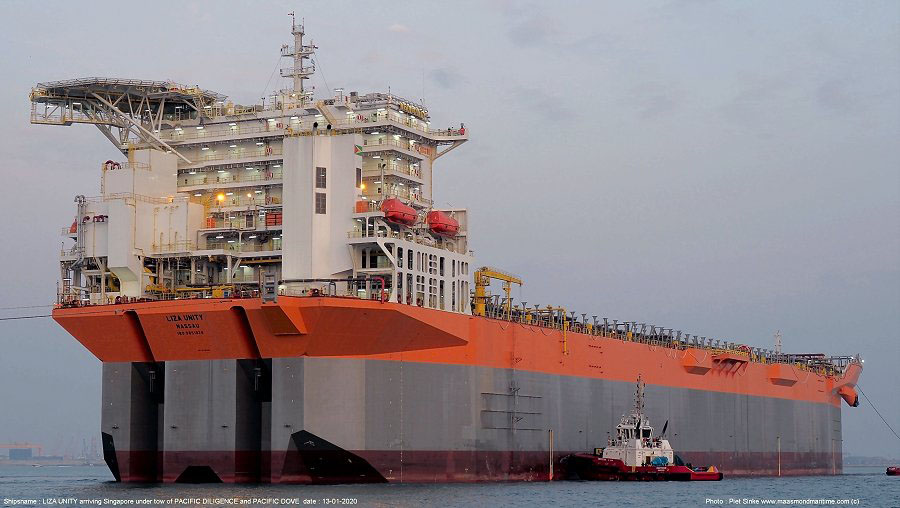With Guyana receiving its first one million barrels of oil from the offshore Liza Unity oil platform, it is expected to net around US$106 million from the sale of the lift amid a huge spike in international fuel prices
President Irfaan Ali yesterday said that government used the spot sale system to sell its share to ExxonMobil, a provision catered for under the crude lifting agreement, even as it continues to seek out a marketer or long term buyer for the remainder of its lifts.
In response to questions from the Sunday Stabroek, Ali explained that ExxonMobil offered the deal at current day Brent price — about US$106 per barrel — but with no marketing fee attached, following a competitive bidding process for the spot sale.
This was later echoed in a release from the Ministry of Natural Resource, which announced that the government would be receiving its first entitlement lift of the Unity Gold crude from the FPSO platform during the period of April 23 to April 24.
“The usual lifting entitlement amount of one million barrels of oil (1MMBBls) will be loaded onto the vessel MV DIMITRIOS by the terminal operator,” it said
“The first cargo of Guyana’s lifting entitlement was sold to ExxonMobil Sales and Supply LLC following a competitive bidding process by the five (5) companies, inclusive of the coventurers of the Stabroek Block,” it added.
The ministry said the bid by ExxonMobil affiliate, EEPGL, was the best on the pricing differential for the crude and this lift will incur no marketing fee by the lifter. “This lift is a one-off arrangement for the company. The GoG will be working to ensure that Guyana receives the best price for each cargo from both the Liza and Unity Gold crudes,” it further noted.
Both the President and Minister of Natural Resources Vickram Bharrat emphasised that Guyana’s overall objective is to get the best value for its resource.
Production from Liza Unity, the second Floating Production Storage and Offloading (FPSO) platform in the offshore Stabroek Block, is currently at 121,000 barrels per day (bpd).
Bharrat added that production volumes will increase as the Unity’s production is ramped up but gave no exact date for when the 220,000 maximum bpd will be reached, although the company has said by the end of this year.
In addition, the 60-day startup flaring period for the Unity expired last week and it is now only on pilot flare.
Bharrat pointed this newspaper to Senior Petroleum Coordinator at the Ministry of Natural Resources Gopnauth Bobby Gossai, Jr. for additional information on the current petroleum management regime, inclusive of offshore flaring.
“EEGPL reported that it achieved background flare on day 60. Flaring averaged 3.7 mcfd in the latest weekly update, April 13th to April 19th, 2022. EEPGL is expected to maintain the background flaring level barring unforeseen events,” the Petroleum Coordinator said.
Exxon starting production at the Liza Unity on February 22 and the 60-day permitted start-up period allowed for flaring without a fine, ended on Friday, April 22.
ExxonMobil’s Liza Destiny FPSO, which has been producing oil since December 2019, has been plagued by technical problems with its flash gas compressor system, leading to millions of cubic feet of climate-endangering gas being pumped into the atmosphere on a daily basis. These problems have not yet been resolved.
The company has promised to have a new flash gas compressor installed on the FPSO by the end of June this year.
In the meantime, it will have to continue paying the US$45 per tonne of carbon dioxide equivalent. This country’s Environmental Protection Agency has received nearly $1 billion in fees from ExxonMobil for flaring. EPA’s head Kemraj Persram could not be reached for a current total. However, as at January of this year, EPA had more than $900M from flaring fines in its coffers.
With regards to the Unity, the company had assured from its initial building that better gas compression technology will be used.
Gossai was quick to point out that the Ministry of Natural Resources Petroleum Management website is operational and that it could be can be accessed at: https://petroleum.gov.gy/data-visualization
Vice President Bharrat Jagdeo had last year assured that the public would be able to assess production information, including revenue received on a portal that the Ministry of Natural Resources would set up.
However, the website’s data centre, which has categories for oil production, gas injected, used, and flared, gas products, oil prices, water injection and water production, shows that most of the information is not up to date. Gas injected and used give information from January 9, 2020 to June 8, 2021 while oil production information stops at March 22 of this year. Water produced and injected give information for the period January 9, 2021 to February 28, 2022. The data for gas produced is dated February 28, 2021.
Of note is that the category showing current prices for oil was up to date, with yesterday’s price averaging at US$105.37 per barrel.






